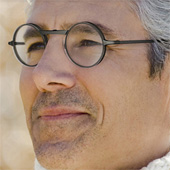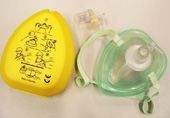June 12th, 2011 by Paul Auerbach, M.D. in Health Tips
1 Comment »


As I write this post, I’m wearing my new Superfocus glasses. I was given the glasses by the company to demonstrate, and they are nothing less than remarkable. I’ve used them mostly in two very common settings for me—indoors and outdoors. In both situations, they performed very well.
Superfocus lenses work by mimicking a young, healthy human eye. Each lens is actually a set of two lenses (flexible and firm). The flexible, inner lens has a transparent membrane attached to a rigid surface, sandwiching a small amount of clear fluid. The bridge (across the nose) connecting the lenses allows you to adjust the shape of the flexible lens. Slide the tab along the bridge to find the exact correction for the particular user. The intent is to achieve clear, undistorted vision within any lighting or distance.
You can learn a great deal from the Superfocus website about the benefits of adjustable lenses, how to obtain the glasses, and so forth. I won’t reiterate information from the website, but rather discuss how I have used these glasses and discuss their performance based on my own experience.
First, I used them during my work in the E.R. as a physician. Read more »
This post, Superfocus Glasses May Improve Vision In The E.R., was originally published on
Healthine.com by Paul Auerbach, M.D..
June 11th, 2011 by Shadowfax in Opinion
No Comments »

It’s ever so satisfying to be proven right. Well, maybe “proven” is too strong a word to use, but there is a bit of strong evidence that, as I have said in the past, the practice of defensive medicine is driven by powerful multifactorial incentives and is very unlikely to change even if the most often-asserted motivator, liability, is controlled. Today, Aaron Carroll guest blogs at Ezra Klein’s WaPo digs:
The argument goes that doctors, afraid of being sued, order lots of extra tests and procedures to protect themselves. This is known as defensive medicine. Tort reform assumes that if we put a cap on the damages plaintiffs can win, then filing cases will be less attractive, fewer claims will be made, insurance companies will save money, malpractice premiums will come down, doctors will feel safer and will practice less defensive medicine, and health-care spending will go way down.[…]
Health Affairs in December, estimated that medical liability system costs were about $55.6 billion in 2008 dollars, or about 2.4 percent of all U.S. health-care spending. Some of that was indemnity payments, and some of it was the cost of components like lawyers, judges, etc.; most of this, however, or about $47 billion, was defensive medicine. So yes, that is real money, and it theoretically could be reduced.
The question is, will tort reform do that? Read more »
*This blog post was originally published at Movin' Meat*
June 5th, 2011 by Shadowfax in Opinion, True Stories
1 Comment »

In my Monday post, I posed a challenging real-life dilemma we recently faced in the ER. As always, I modified the posited case from the actual facts but the broad outlines were true to life: A young person of questionable capacity wants to refuse lifesaving treatment.
Short answer, for those not interested in the discussion: This case is a no-brainer. You intubate. In this case, sadly, the outcome was not good. As I hinted, early hypoxia in the setting of blunt chest trauma is a bad sign. The patient was intubated, but became progressively more difficult to ventilate over the next couple of days and subsequently died. The family was at the bedside and, from what I understand, they were very happy to be able to be with him in his final hours. On the other hand, due to his drug abuse, he proved extremely difficult to sedate (even on max propofol!) and was agitated and combative, in restraints, until hypoxia began to take its toll. While I am confident I did the “right” thing, the tally sheet is decidedly mixed as to whether was beneficent in its effect.
Discussion: Read more »
*This blog post was originally published at Movin' Meat*
June 1st, 2011 by Paul Auerbach, M.D. in Health Tips, Research
No Comments »

 When a person performs cardiopulmonary (heart and lung) resuscitation (CPR), it is sometimes recommended to provide rescue breathing. This is certainly the case when the primary cause of the victim’s difficulty relates to failure to breathe adequately, such as with a drowning episode. When CPR first arrived on the landscape, laypersons were trained to perform mouth-to-mouth breathing (for adults) or mouth-to-mouth and nose breathing (for infants and small children).
When a person performs cardiopulmonary (heart and lung) resuscitation (CPR), it is sometimes recommended to provide rescue breathing. This is certainly the case when the primary cause of the victim’s difficulty relates to failure to breathe adequately, such as with a drowning episode. When CPR first arrived on the landscape, laypersons were trained to perform mouth-to-mouth breathing (for adults) or mouth-to-mouth and nose breathing (for infants and small children).
Following growing concern about transmission of diseases from blood and body fluids, laypersons were introduced to using masks or something similar to allow them to provide breathing assistance (“artificial respiration,” “artificial ventilation,” “rescue breathing,” etc.) to non-breathing persons. Masks have been used for decades by professional rescuers for ventilating patients, often in conjunction with the use of bags in a “bag-valve-mask” configuration. The valve between the mask and bag provides for one-way flow and prevents the backwash of vomitus, blood, liquid from the lungs, or other fluids that might diminish the effectiveness of the technique.
A number of excellent masks and face shields are available on the market for rescuers to be able to (relatively) safely blow air into a victim’s lungs. One example is Read more »
This post, CPR: Mouth-to-Mouth Breathing May Have Some Advantages Over Mask-Assisted Breathing, was originally published on
Healthine.com by Paul Auerbach, M.D..
May 27th, 2011 by RamonaBatesMD in Health Tips
No Comments »

Last year I didn’t write about dog bite prevention until the first week of June even though I know National Dog Bite Prevention Week is always the third full of week of May.
The numbers shared by the American Veterinary Medical Association (AVMA) haven’t changed: 4.7 million people are bitten by dogs each year in the US with 800,000 of them requiring medical attention.
 If you have read this blog for very long, you know I dearly love my dogs — deceased ones (Columbo, Ladybug (photo), and Girlfriend) and the living one, Rusty. Still, I have no illusions that dogs bite and given the right provocation, I think mine would though most of the time they are totally harmless and would just invite you in to rob me.
If you have read this blog for very long, you know I dearly love my dogs — deceased ones (Columbo, Ladybug (photo), and Girlfriend) and the living one, Rusty. Still, I have no illusions that dogs bite and given the right provocation, I think mine would though most of the time they are totally harmless and would just invite you in to rob me.
Sadly, children are by far the most common victims of dog bites, occurring most often in children 5-9 years of age. Senior citizens are the second most common dog bite victims.
Children are also more likely to be severely injured and represent half of the dog-bite victims requiring medical attention every year. Almost two thirds of injuries among children Read more »
*This blog post was originally published at Suture for a Living*





 When a person performs cardiopulmonary (heart and lung) resuscitation (CPR), it is sometimes recommended to provide rescue breathing. This is certainly the case when the primary cause of the victim’s difficulty relates to failure to breathe adequately, such as with a drowning episode. When CPR first arrived on the landscape, laypersons were trained to perform mouth-to-mouth breathing (for adults) or mouth-to-mouth and nose breathing (for infants and small children).
When a person performs cardiopulmonary (heart and lung) resuscitation (CPR), it is sometimes recommended to provide rescue breathing. This is certainly the case when the primary cause of the victim’s difficulty relates to failure to breathe adequately, such as with a drowning episode. When CPR first arrived on the landscape, laypersons were trained to perform mouth-to-mouth breathing (for adults) or mouth-to-mouth and nose breathing (for infants and small children).









